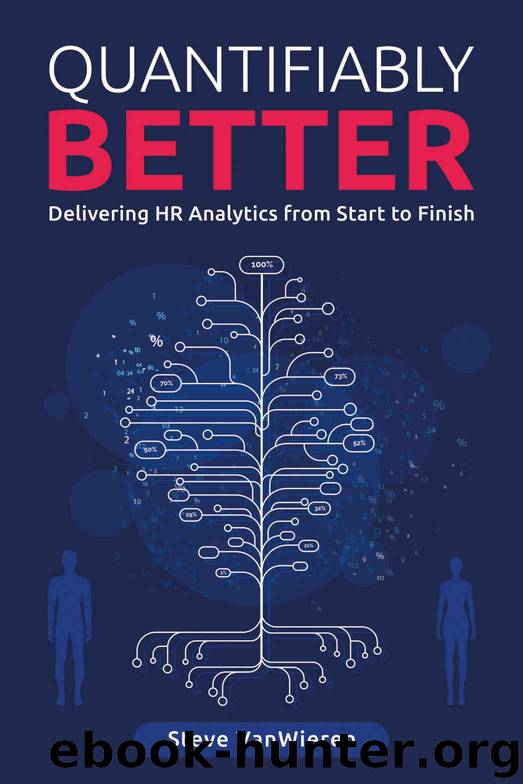Quantifiably Better: Delivering Human Resource (HR) Analytics from Start to Finish by Steve VanWieren

Author:Steve VanWieren [VanWieren, Steve]
Language: eng
Format: azw3
Publisher: Technics Publications
Published: 2017-03-11T05:00:00+00:00
Success Leaves Clues
In motivational speaker Tony Robbins’ book Unlimited Power, he makes the following statement:
“Long ago, I realized that success leaves clues, and that people who produce outstanding results do specific things to create those results.”17
When you begin to go down the path of having a data-driven HR department, you actually prove this quote to be true. Why? You aren’t working solely from your gut anymore - instead you have INSIGHT that backs up every step.
There is a key word in this sentence, though, that you may have overlooked: it is the word do. The quote doesn’t say that people who produce outstanding results generate amazing charts and visualizations. It says that these people do something to create great results.
In 1956, cognitive psychologist George A. Miller produced a paper that is frequently referenced amongst psychologists called “The Magical Number Seven, Plus or Minus Two: Some Limits on Our Capacity for Processing Information.”18 The theory is that the brain can only process so much stimulation at any instant point in time: 5 to 9 things, to be precise.
Based on this theory, if a manager is trying to manually keep up with more than 5 to 9 attributes on his employees at a given point in time, he would benefit by having guidance provided to him. For example, typical good predictive analytics algorithms contain 30+ attributes, which is why they can be so valuable in your journey. The human brain simply cannot comprehend this many details simultaneously. Similarly, if the right action requires a complex calculation of 30+ clues, trying to do this instantaneously in your mind is almost impossible.
How you discover the clues is another story. If you have generated a group of attributes with the data manipulation step, then you will be ahead of the curve. You will start to be able to tie the opinionated ways to measure things (like engagement, culture, and high potentials) to the non-opinionated ways to measure things (like sales, growth, or productivity).
In Malcolm Gladwell’s outstanding book Outliers: The Story of Success, he discusses how it takes 10,000 hours to become an expert at something.19 That is the equivalent of 5 years’ worth of work - 40 hours a week for 5 straight years. You cannot and should not expect to be perfect in practicing the discovery of clues immediately.
And you should not be afraid to share this point with the business. Tell the leadership team where you are in your journey, and that your next steps are to start to ACT on all of the INSIGHT that you have found. They may ask questions about the specific actions you are going to take, and your response should be that you do not know yet. Make sure you include the word yet. Emphasize it.
You may even persuade your leadership team to hire a data and analytics person to help you. They might even fund it if they are seeing the benefit.
Download
This site does not store any files on its server. We only index and link to content provided by other sites. Please contact the content providers to delete copyright contents if any and email us, we'll remove relevant links or contents immediately.
Sass and Compass in Action by Wynn Netherland Nathan Weizenbaum Chris Eppstein Brandon Mathis(7968)
Supercharging Productivity with Trello by Brittany Joiner(7325)
Mastering Tableau 2023 - Fourth Edition by Marleen Meier(7094)
Inkscape by Example by István Szép(6965)
Secrets of the JavaScript Ninja by John Resig Bear Bibeault(6736)
Visualize Complex Processes with Microsoft Visio by David J Parker & Šenaj Lelić(6644)
Build Stunning Real-time VFX with Unreal Engine 5 by Hrishikesh Andurlekar(5674)
Design Made Easy with Inkscape by Christopher Rogers(4995)
Customizing Microsoft Teams by Gopi Kondameda(4539)
Business Intelligence Career Master Plan by Eduardo Chavez & Danny Moncada(4436)
Extending Microsoft Power Apps with Power Apps Component Framework by Danish Naglekar(4150)
Salesforce Platform Enterprise Architecture - Fourth Edition by Andrew Fawcett(4012)
Linux Device Driver Development Cookbook by Rodolfo Giometti(4008)
Pandas Cookbook by Theodore Petrou(4003)
The Tableau Workshop by Sumit Gupta Sylvester Pinto Shweta Sankhe-Savale JC Gillet and Kenneth Michael Cherven(3815)
Exploring Microsoft Excel's Hidden Treasures by David Ringstrom(3290)
TCP IP by Todd Lammle(3118)
Applied Predictive Modeling by Max Kuhn & Kjell Johnson(3006)
Drawing Shortcuts: Developing Quick Drawing Skills Using Today's Technology by Leggitt Jim(2975)
